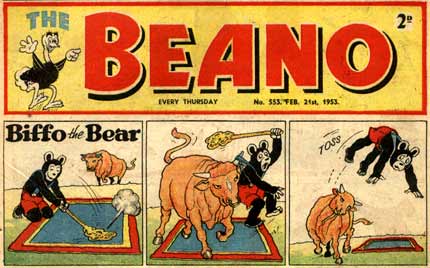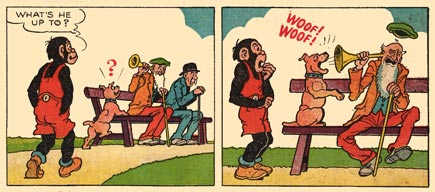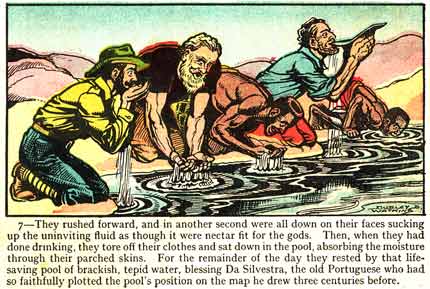'Biffo the Bear'.
A son of a lithographic print artist, Dudley D. Watkins showed early artistic talent. In 1923, his first published artwork, a drawing entitled 'Our Gymnasium Class', appeared in Boots' staff magazine, The Beacon. In 1925, his family moved to Scotland, where Watkins attended classes at Glasgow Art School.
Header for 'King Solomon's Mines', an adaptation of Henry Rider Haggard's novel of the same name.
Watkins started to work for publisher D.C. Thompson for a trial period of six months, and remained at this publisher until his death in 1969. After several years of illustration work, Dudley D. Watkins began drawing comics. On 11 February 1928 he created 'Morgyn the Mighty', first published in issue #304 of the comic magazine Rover. It was originally a text comic about a physically strong man who is the sole survivor of a shipwreck. Morgyn manages to reach an undiscovered island where he fights local wild animals.
'Mickey the Monkey'.
Starting in 1936, Dudley Watkins drew two comics for the Fun Section supplement of the Sunday Post: 'The Broons' and 'Oor Wullie'. These comics were written using full dialect and were a great success. Other series Dudley D. Watkins made were 'Our Gang', 'Smarty Grandpa', 'Lord Snooty', and 'Desperate Dan'.
Comic art by Dudley D. Watkins.
Because of his loyalty to Beano- and Dandy editor D.C. Thomson and his success, Dudley Watkins was their only artist permitted to sign his work, making him the best known British comic artist of his time. Following his death in 1969, his characters and style were faithfully maintained, especially by Ken H. Harrison, who continued 'Oor Wullie', 'The Broons' and 'Desperate Dan'.
Dudley D. Watkins was an influence on Leo Baxendale and David Sutherland.
'Oor Wullie'.






